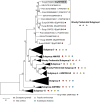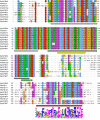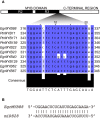The Woody-Preferential Gene EgMYB88 Regulates the Biosynthesis of Phenylpropanoid-Derived Compounds in Wood
- PMID: 27713753
- PMCID: PMC5032791
- DOI: 10.3389/fpls.2016.01422
The Woody-Preferential Gene EgMYB88 Regulates the Biosynthesis of Phenylpropanoid-Derived Compounds in Wood
Abstract
Comparative phylogenetic analyses of the R2R3-MYB transcription factor family revealed that five subgroups were preferentially found in woody species and were totally absent from Brassicaceae and monocots (Soler et al., 2015). Here, we analyzed one of these subgroups (WPS-I) for which no gene had been yet characterized. Most Eucalyptus members of WPS-I are preferentially expressed in the vascular cambium, the secondary meristem responsible for tree radial growth. We focused on EgMYB88, which is the most specifically and highly expressed in vascular tissues, and showed that it behaves as a transcriptional activator in yeast. Then, we functionally characterized EgMYB88 in both transgenic Arabidopsis and poplar plants overexpressing either the native or the dominant repression form (fused to the Ethylene-responsive element binding factor-associated Amphiphilic Repression motif, EAR). The transgenic Arabidopsis lines had no phenotype whereas the poplar lines overexpressing EgMYB88 exhibited a substantial increase in the levels of the flavonoid catechin and of some salicinoid phenolic glycosides (salicortin, salireposide, and tremulacin), in agreement with the increase of the transcript levels of landmark biosynthetic genes. A change in the lignin structure (increase in the syringyl vs. guaiacyl, S/G ratio) was also observed. Poplar lines overexpressing the EgMYB88 dominant repression form did not show a strict opposite phenotype. The level of catechin was reduced, but the levels of the salicinoid phenolic glycosides and the S/G ratio remained unchanged. In addition, they showed a reduction in soluble oligolignols containing sinapyl p-hydroxybenzoate accompanied by a mild reduction of the insoluble lignin content. Altogether, these results suggest that EgMYB88, and more largely members of the WPS-I group, could control in cambium and in the first layers of differentiating xylem the biosynthesis of some phenylpropanoid-derived secondary metabolites including lignin.
Keywords: Eucalyptus; MYB transcription factors; flavonoids; lignin; oligolignols; phenylpropanoid metabolism; salicinoid phenolic glycosides; vascular cambium.
Figures








References
LinkOut - more resources
Full Text Sources
Other Literature Sources
Molecular Biology Databases

